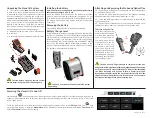
Part 2 Installation
2.4
Electrical Connections
Rear Imagine of Controller
TOP
BOTTOM
Pin 1:
Power (+)
Pin 2:
Power (-)
Pin 3:
4-20mA (+)
Pin 4:
4 - 20mA (-)
Pin 5:
Sensor (+)
Pin 6:
Sensor (-)
Pin 7:
ATC (+)
Pin 8:
ATC (-)
Pin 9:
Relay Contact 1 NO
Pin 10:
Relay Contact 1 COM
Pin 11:
Relay Contact 1 NC
Pin 12:
Relay Contact 2 NO
Pin 13:
Relay Contact 2 COM
Pin 14:
Relay Contact 2 NC
Pin 15:
Range ID (+)
Pin 16:
Range ID (-)
The OMD-501D accepts a 12 - 28VDC Power supply with a 1 amp minimum rating as standard. The maxi-
mum power consumption is 8 watts. The unit has an optional 100-240VAC power supply. Verify which
power your unit has been configured with. The unit uses a screw type terminal block for electrical connec-
tions and is located at the rear of the analyzer.
The analyzer is supplied with internal protection should the polarity of the power be connected in reverse,
it is recommended to check polarity before running power to the unit. It is also recommended to add an
external fuse to the power inlet, the analyzer does have a built in fuse, but an external fuse is suggested
for
ease of access
.
2.5
Gas Connections
The OMD-501D with its standard H3 flow through housing is designed for positive pressure samples and re-
quires incoming sample lines. The user is responsible for added sample system components as well as sourc-
ing a calibration gas.
It is recommended to use Stainless Steel Tubing or a low permeable plastic tubing.
•
Flow rate should be between 0.5 - 3 SCFH
•
Inlet pressure should be between 5 - 60 PSIG
•
Analyzer should be vented to atmosphere, take precau-
tion to make sure vent does not get blocked
1
2
3
4
1 Sample Gas Inlet, goes into Flow Valve
2. Bypass valve, allows user to isolate sensor during shutdown.
3. H3 Sensor Housing
4. Flow Meter, Vent to Atmosphere
Recommended Sample System






































